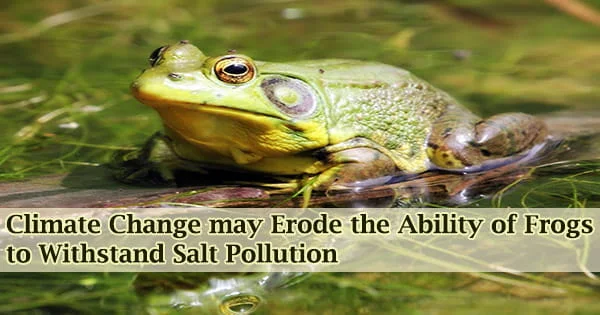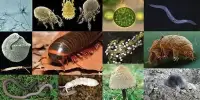According to experts at Binghamton University, State University of New York, climate change may weaken frogs’ resistance to exposure to road salt pollution.
The northeastern United States springs are now sooner and more erratic in temperature than they used to be, a trend that has had an impact on ecosystems. Amphibians that spawn in the spring, such as wood frogs, are among those most severely impacted because they could be tempted out of the mud to mate too early.
Adult wood frogs will probably survive the cold when winter returns quickly, but their freshly placed eggs might not. However, new analysis by the Biological Sciences Department at Binghamton University indicates that the effects continue.
Later broods of hatchlings whose parents endure freezing temperatures associated with an additional winter storm are larger but less resilient to the effects of road salt, a common wetland pollutant, according to doctoral candidate Nicholas Buss, Assistant Research Professor Lindsey Swierk, and Associate Professor Jessica Hua in “Amphibian breeding phenology influences offspring size and response to a common wetland contaminant,” published recently in Frontiers in Zoology.
The study focuses on a number of wood frog populations that are approximately a 412-hour drive southwest of Binghamton and normally start breeding between mid-March and mid-April.
Additionally, salt is discussed as a typical but occasionally disregarded environmental pollutant. The 10 million metric tons of road salt that are used each winter in North America wash off the roads when the snow melts and the rain starts to fall in the spring.
According to Buss, this discharge can make nearby wetlands more salinous and endanger freshwater species like amphibians. Amphibians play a crucial role in the ecosystems of wetlands.
Our results suggest that the effects of climate change on wood frog breeding are complex, depending on the severity of freezing events from year to year, and are interactive with other human-introduced stressors like contaminants.
Professor Lindsey Swierk
Amphibian tadpoles graze on algae, which improves the clarity and cleanliness of wetlands’ water. Tadpoles are significant contributors to the nutrient cycle in wetland ecosystems because they are prey for numerous species of aquatic invertebrates.
Early spring and offspring
Hua highlighted that a number of variables influence amphibian mating, which frequently depends on both temperature and the timing of spring rain. Researchers can anticipate the breeding season for wood frogs in particular by observing the absence of ice on the pond, a run of three to four days above freezing, and rain on those days.
Even though amphibians have chilly blood, warmer weather isn’t always preferable. According to Swierk, they changed their breeding cycles over thousands of years in response to environmental stimuli. Contrarily, the pace of recent climate change has been tremendous, pushing many species’ adaptability to the limit.
“Our results suggest that the effects of climate change on wood frog breeding are complex, depending on the severity of freezing events from year to year, and are interactive with other human-introduced stressors like contaminants,” she said.
Due to special adaptations that enable them to endure subfreezing conditions, adult frogs that emerge during a fake spring frequently have a chance of survival. Perhaps the situation with the eggs is different.
“Though each wood frog female can lay over 500 eggs, many of these eggs may be vulnerable if the pond freezes over,” Hua said.
“The embryos, too, are hit hard by sudden cold. In a previous study, the researchers exposed frog embryos to cold conditions and found that they took longer to develop into tadpoles, weighed less after hatching and were less tolerant of road salt than embryos raised in warmer environments,” Buss said.
The eggs were taken out of their natural environment and raised in a lab for the study that was published in Frontiers in Zoology. They discovered that eggs from parents exposed to a second winter storm and laid later in the mating season were less likely to tolerate salt pollution.
The researchers hypothesize that frogs that bred earlier than those that bred later were subjected to less temperature-induced stress, which may have resulted in less physiological stress and a better ability for those early breeders to acclimatize to increasing salt in the environment.
“While stress hormones can allow animals to survive when faced with temporary adverse conditions, prolonged or severe exposure to stressors can cause those same hormones to have ill effects,” Swierk said.
“Chronically elevated stress hormones can have cascading impacts on other hormones, such as those related to homeostasis, growth, or reproduction,” she explained.
“In the short-term and on the local scale, it’s not possible for us to change these larger climate patterns. However, local management can be made aware of the exacerbating effects of pond contaminants on amphibians that breed too early,” Swierk said. “From an evolutionary perspective, it is fascinating to understand how animals can adapt, or fail to adapt, to rapid changes in their environment,” she said.
















